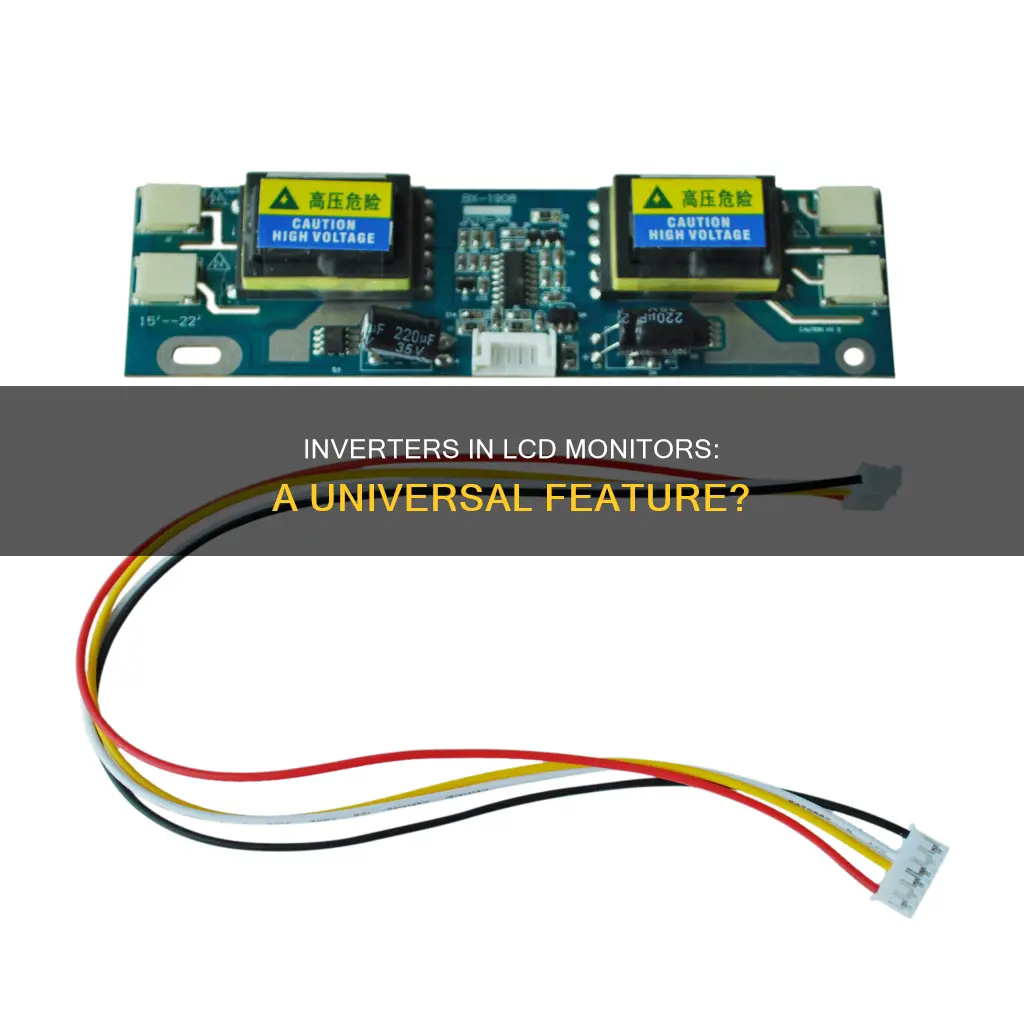
An inverter is a pen-sized board that is usually placed at the bottom of an LCD screen, either in the same case or above the keyboard. It is an essential part of many LCD screens, as it allows the display to be lit by providing power to the screen's backlight. However, not all LCD screens require an inverter. LED screens, for example, do not use an inverter as they do not need high voltages and require a DC voltage. CCFL (Cold Cathode Fluorescent Light) screens, on the other hand, typically require an inverter to convert DC power to AC power for the backlight. Therefore, it is safe to say that not all LCD monitors have inverters, as it depends on the type of backlight used.
| Characteristics | Values |
|---|---|
| What is an LCD inverter? | A component that prepares the power connection of the DC power supply to work with the AC power requirements of the lamp. |
| Why is it needed? | An LCD inverter is needed to convert the direct current (DC) from the laptop into the alternating current (AC) needed by the backlight. Without the inverter, the screen would remain dark. |
| Where is it located? | The inverter is usually located near the screen, either in the same case with the LCD screen or above the keyboard. |
| What are CCFL and LED? | CCFL (Cold Cathode Fluorescent Light) and LED are the two types of backlight in LCD screens. CCFL is an older technology that uses fluorescent tubes, while LED is a newer technology that uses diodes to produce light. |
| Do LED screens use inverters? | LED screens do not usually use power inverters, but some may still require an inverter to control the brightness and dimming of the LEDs. |
| Do all LCD monitors have inverters? | No, only LCD monitors with CCFL backlights require inverters. Modern LCD screens often use LED backlights that do not need inverters. |
What You'll Learn

The role of an LCD inverter
The LCD inverter is an essential component in many laptops and monitors, including TVs, computer monitors, smartphones, and tablets. Its main function is to power the screen's backlight by converting the direct current (DC) from the device's battery or power supply into the alternating current (AC) required by the backlight. This process ensures that the LCD screen is illuminated, allowing users to view images clearly.
The inverter is typically located near the screen, either at the bottom or above the keyboard, and its role remains constant even as technology evolves. When a computer is plugged into an AC power outlet, the power is converted into DC, which works well for digital components but not for fluorescent bulbs. This is where the inverter comes into play, intercepting the DC power and converting it back into AC power for the bulb that illuminates the screen.
There are two main types of LCD backlights that utilise inverters: Cold Cathode Fluorescent Lamp (CCFL) and Light Emitting Diode (LED). CCFL, an older technology, requires high voltages to operate and hence, needs an inverter. On the other hand, LED backlights can sometimes run on DC power, but they may still require an inverter to control brightness and dimming.
Common issues with LCD inverters include a dim or flickering screen, or even a completely dead screen. Troubleshooting steps include checking power connections, testing the inverter's output voltage, and, if necessary, replacing the inverter with the assistance of a qualified technician.
Monitor Lizard Size: Understanding Their Massive Growth
You may want to see also

LCD inverters and display illumination
LCD, or liquid crystal displays, are found in everything from TVs and computer monitors to smartphones and tablets. An LCD inverter is an essential part of many LCD screens, helping to power the screen's backlight and make it visible to the user. The inverter converts the direct current (DC) from the device's battery or power supply into the alternating current (AC) required by the backlight. This process is crucial for the visibility of the screen's display, especially under various lighting conditions.
There are two main types of LCD backlights that use inverters:
- Cold Cathode Fluorescent Lamp (CCFL): This older technology uses fluorescent tubes to produce light and requires high voltages to operate, necessitating an inverter. CCFL screens are typically found in laptop displays, with Dell being the only company that attaches an inverter to the LCD.
- Light Emitting Diode (LED): This newer technology uses LEDs to generate light. While some LED backlights can operate on DC power, certain models still require an inverter to control the brightness and dimming of the LEDs.
It is important to note that LED screens do not always require power inverters since they do not need the high voltages of a cathode lamp and operate on DC voltage.
When an LCD inverter fails, common signs include a dim or flickering screen, or even a completely dead screen. Troubleshooting steps include checking power connections and testing the inverter's output voltage with a multimeter. If the inverter is faulty, it typically needs to be replaced by a qualified technician.
In conclusion, LCD inverters play a critical role in display illumination by converting DC power to AC power for the backlight. While their future may be uncertain due to the increasing efficiency and affordability of LED backlights, they remain an essential component in many LCD displays today.
Asus ROG Monitors: Premium Price, Premium Experience?
You may want to see also

Types of LCD inverters
LCD screens can be of two types: LED and CCFL. LED screens do not require an inverter as they do not need high voltages or a cathode lamp. CCFL screens, on the other hand, use a cold-cathode fluorescent lamp that requires an inverter, commonly known as a CCFL inverter. This component converts the DC power supply to AC power, which is required by the lamp.
CCFL screens are typically found in Dell laptops, and the inverter is usually attached to the bottom of the LCD screen, held by two screws or double-sided tape. However, not all CCFL screens for Dell will have an inverter attached.
When an inverter breaks, the LCD screen will appear to be shut off, but upon closer inspection, you will still see that the display is working as images are still being rendered but are not illuminated. In such cases, it is often more cost-effective to replace the entire LCD than to change the inverter unit, as many LCD fluorescent bulbs are integrated onto a circuit with the inverter, requiring them to be replaced together.
CenturyLink and Cox: Monitoring Your Internet Data Usage?
You may want to see also

Troubleshooting and repairing LCD inverters
Troubleshooting and repairing an LCD inverter requires careful steps and caution when working with electronics and high voltage. Here is a comprehensive guide to help you through the process:
Troubleshooting:
- Unplug the device: Always disconnect the power source before beginning any repairs for safety reasons.
- Identify the problem: The most common symptom of a faulty inverter is a lack of backlight, resulting in a dim or black screen. Shine a flashlight on the screen to check for a faint image.
- Inspect the inverter: Locate the inverter, usually a small circuit board with high-voltage wires connected to the backlight lamps. Look for visible damage such as burnt components, cracked solder joints, or swollen capacitors.
- Use a multimeter: Test the components for continuity and proper voltage levels with a multimeter to confirm if the inverter is faulty.
Repairing:
- Wear protective gear: Use safety glasses and gloves to protect yourself from electrical shock and sharp objects.
- Work in a well-ventilated area: Solder fumes can be harmful, so ensure proper ventilation during the repair process.
- Disassemble the device: Carefully follow the manufacturer’s instructions or online guides specific to your device model. Take note of the screws and cable connections to ensure proper reassembly.
- Replace faulty components: If you find damaged components, replace them with compatible parts. Use the correct soldering techniques to avoid causing further damage.
- Reassemble the device: Carefully reconnect all cables and screws. Double-check your work before plugging in the device.
- Test the device: Plug in the device and turn it on. If the backlight works correctly, you have successfully repaired the inverter.
Additional Tips:
- Use the correct tools: The right tools will make the repair process easier and safer.
- Take your time: Rushing can lead to mistakes and further damage. Be patient and methodical.
- Document your work: Take pictures or notes as you go to facilitate reassembly and help identify any issues.
- Research online: Online resources and forums can provide additional guidance and troubleshooting tips for specific scenarios.
- Know your limits: If you are unsure about a step or encounter a complex issue, seek professional help.
- Warranty considerations: Remember that attempting repairs yourself may void the warranty on your device. Proceed at your own risk and always prioritize safety.
Trending Monitor Size: What Screen Dimensions Reign Supreme?
You may want to see also

The future of LCD inverters
The LCD inverter is an essential component of many LCD screens, including those in laptops, monitors, and TVs. Its primary function is to convert the direct current (DC) from the device's battery or power supply into the alternating current (AC) required to power the screen's backlight. This backlight is what allows you to see images on the LCD panel.
While LCD inverters are still widely used, their future is uncertain due to the increasing efficiency and affordability of LED backlights, which may reduce the demand for inverters. However, for the foreseeable future, LCD inverters will continue to play a crucial role in display technology.
The two main types of LCD backlights that use inverters are:
- Cold Cathode Fluorescent Lamp (CCFL): This older technology uses fluorescent tubes to produce light and requires high voltages to operate, hence the need for an inverter.
- Light Emitting Diode (LED): This newer technology uses LEDs to generate light. While some LED backlights can operate on DC power alone, others still require an inverter to control brightness and dimming.
Inverter boards typically consist of a circuit with components like transistors, resistors, capacitors, and sometimes a fuse. These components collaborate to regulate electricity flow and generate the voltage required to power the backlight.
Identifying a failing LCD inverter is often possible through signs such as a flickering or dim screen. Repairing or replacing an LCD inverter involves carefully disassembling the device, locating and inspecting the inverter, and, if necessary, replacing faulty components or the entire inverter board.
Is Your App Usage Being Monitored? Here's How to Know
You may want to see also
Frequently asked questions
No, only LCD monitors with CCFL backlights require an inverter. LED backlights do not need an inverter.
An inverter is a pen-sized board that provides power to the screen's backlight. It converts the direct current (DC) from the device's battery or power supply into the alternating current (AC) required by the backlight.
The easiest way to tell is to look at a picture of the screen. For example, all screens for the Dell Latitude D620 come with an inverter attached to the bottom of the LCD.
When an inverter breaks, the LCD screen will appear to be shut off, but if you look closely, you will still see that the display is working as images are still being rendered but are not illuminated.
Yes, you can fix an inverter by first checking the power connections and testing the inverter's output voltage using a multimeter. If the inverter is faulty, you can replace it by disconnecting its wires and unscrewing it from the motherboard or frame.







